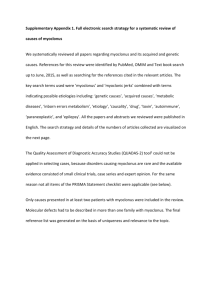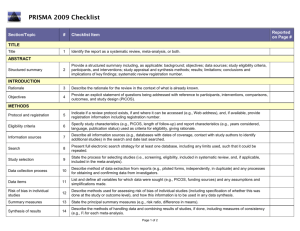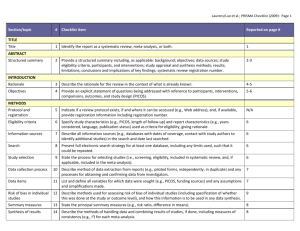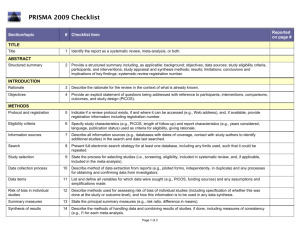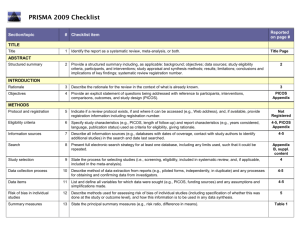Guidelines for Systematic Reviews
advertisement
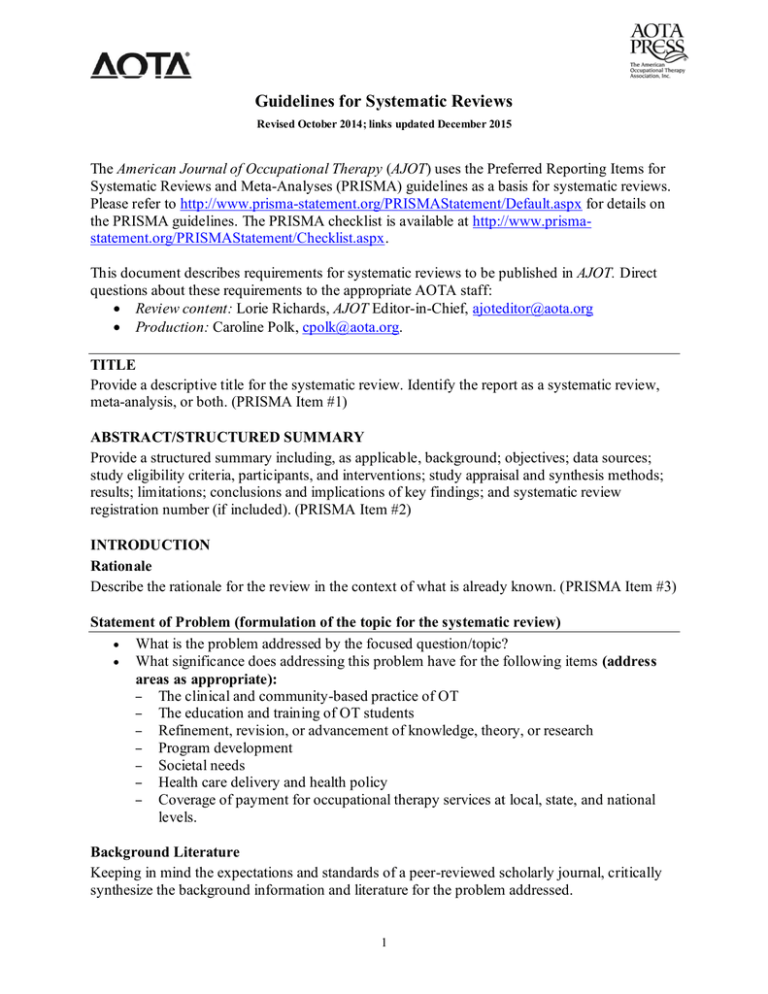
Guidelines for Systematic Reviews Revised October 2014; links updated December 2015 The American Journal of Occupational Therapy (AJOT) uses the Preferred Reporting Items for Systematic Reviews and Meta-Analyses (PRISMA) guidelines as a basis for systematic reviews. Please refer to http://www.prisma-statement.org/PRISMAStatement/Default.aspx for details on the PRISMA guidelines. The PRISMA checklist is available at http://www.prismastatement.org/PRISMAStatement/Checklist.aspx. This document describes requirements for systematic reviews to be published in AJOT. Direct questions about these requirements to the appropriate AOTA staff: Review content: Lorie Richards, AJOT Editor-in-Chief, ajoteditor@aota.org Production: Caroline Polk, cpolk@aota.org. TITLE Provide a descriptive title for the systematic review. Identify the report as a systematic review, meta-analysis, or both. (PRISMA Item #1) ABSTRACT/STRUCTURED SUMMARY Provide a structured summary including, as applicable, background; objectives; data sources; study eligibility criteria, participants, and interventions; study appraisal and synthesis methods; results; limitations; conclusions and implications of key findings; and systematic review registration number (if included). (PRISMA Item #2) INTRODUCTION Rationale Describe the rationale for the review in the context of what is already known. (PRISMA Item #3) Statement of Problem (formulation of the topic for the systematic review) What is the problem addressed by the focused question/topic? What significance does addressing this problem have for the following items (address areas as appropriate): – The clinical and community-based practice of OT – The education and training of OT students – Refinement, revision, or advancement of knowledge, theory, or research – Program development – Societal needs – Health care delivery and health policy – Coverage of payment for occupational therapy services at local, state, and national levels. Background Literature Keeping in mind the expectations and standards of a peer-reviewed scholarly journal, critically synthesize the background information and literature for the problem addressed. 1 What is currently known about the problem, and what is not yet known? Provide relevant definitions and descriptions of the intervention and approach, as needed. Discuss how this systematic review will contribute to our understanding or resolution of the problem addressed. Objectives of the Systematic Review Provide an explicit statement of questions being addressed with reference to participants, interventions, comparisons, outcomes, and study design (PICOS), as appropriate. (PRISMA Item #4) If the focused question is part of a group of systematic reviews on a topic, state the importance of the focused question relative to the overall topic. METHOD FOR CONDUCTING THE SYSTEMATIC REVIEW In this section, describe the following: Whether a systematic review protocol exists and if and where it can be accessed (e.g., URL of website). If available, provide registration information, including registration number. (PRISMA Item #5) Search strategy, including inclusion and exclusion criteria and screening procedures – List who conducted the search (e.g., independent librarian, librarian associated with author’s institution). – Specify study characteristics (e.g., PICOS, length of follow-up) and report characteristics (e.g., years considered, language, publication status) used as criteria for eligibility, giving rationale. (PRISMA Item #6) – Present full electronic search strategy for at least one database, including any limits used, such that it could be repeated. (PRISMA Item #8) Procedures for identification and collection of articles – List databases and other information sources used to identify relevant studies (e.g., hand-searching reference lists and tables of contents, contacting content experts). Include dates of coverage of the search. (PRISMA Item #7) – State the process for selecting studies (i.e., screening, eligibility, criteria for inclusion in systematic review and, if applicable, criteria for inclusion in the meta-analysis). (PRISMA Item #9) – Describe method of data extraction from reports (e.g., piloted forms, independently, in duplicate) and any processes for obtaining and confirming data from investigators. (PRISMA Item #10) – List and define all variables for which data were sought (e.g., PICOS, funding sources) and any assumptions and simplifications made. (PRISMA Item #11) – Describe method for assessing risk of bias of individual studies (including specification of whether this was done at the study or outcome level) and how this information is to be used in any data synthesis. (PRISMA Item #12) – State the principal summary measures (e.g., risk ratio, difference in means). (PRISMA Item #13). – Describe the method of handling data and combining results of studies, if done, including measures of consistency (e.g., I2) for each meta-analysis. (PRISMA Item #14) 2 – – Specify any assessment of risk of bias that may affect the cumulative evidence (e.g., publication bias, selective reporting within studies). (PRISMA Item #15) Describe methods of additional analyses (e.g., sensitivity or subgroup analyses, metaregression), if done, indicating which were pre-specified.* (PRISMA Item #16) RESULTS Give numbers of studies screened, assessed for eligibility, and included in the review, with reasons for exclusions at each stage. Provide a flow diagram using the format shown in the Flow Diagram on p. 9. (PRISMA Item #17) For each study, present characteristics for which data were extracted (e.g., study size, PICOS, follow-up period) and provide the citations. (PRISMA Item #18) Present data on risk of bias of each study and, if available, any outcome level assessment (see item in Method section corresponding to PRISMA Item #12). (PRISMA Item #19) For all outcomes considered (benefits or harms), present for each study (1) simple summary data for each intervention group and (2) effect estimates and confidence intervals, using a forest plot as appropriate. (PRISMA Item #20) Present the main results of the review. If meta-analyses are done, include for each, confidence intervals and measures of consistency. (PRISMA Item #21) Present results of any assessment of risk of bias across studies (see PRISMA Item #15). (PRISMA Item #22). Provide a table summarizing the risk of bias using the format shown in Table Template 1 on p. 7). Give results of additional analyses, if done (e.g., sensitivity or subgroup analyses, metaregression [see item * in Method section corresponding to PRISMA Item #16). (PRISMA Item #23) To synthesize the articles and create the results, do the following: Organize studies according to themes. Organize and group studies within the themes, rather than report on results of individual studies. Synthesize by answering the question, “What do we know, from an evidence-based perspective, about specific dimensions of the focused question?” The synthesis must reflect the strength of the findings in relation to the types of study design (Level) and the methodological weaknesses present (biases and study limitations). Although there can be study limitations at all levels, please keep in mind that results from a Level I, II, or III study will provide stronger evidence than results from Levels IV or V. Levels of evidence are described in Table 1. Include a table summarizing the evidence generated from each study. Use the format shown in Table Template 2, and refer to the guidelines on p. 6. 3 Table 1. Levels of Evidence Level I Systematic reviews, meta-analyses, randomized controlled trials Level II Two groups, nonrandomized studies (e.g., cohort, case-control) Level III One group, nonrandomized (e.g., before and after, pretest and posttest) Level IV Descriptive studies that include analysis of outcomes (single-subject design, case series) Level V Case reports and expert opinion that include narrative literature reviews and consensus statements Note. Qualitative studies do not include a level of evidence and typically are not included in a systematic review. From “Evidence-Based Medicine: What It Is and What It Isn’t,” by D. L. Sackett, W. M. Rosenberg, J. A. Muir Gray, R. B. Haynes, & W. S. Richardson, 1996, British Medical Journal, 312, pp. 71–72. Copyright © 1996 by the British Medical Association. Adapted with permission. In addition, the evidence within a theme should be described according to the strength of the evidence. The strength of the evidence is based on the guidelines of the U.S. Preventive Services Task Force (http://www.uspreventiveservicestaskforce.org/uspstf/grades.htm) and is defined as follows: – Strong evidence includes consistent results from well-conducted studies, usually at least two randomized controlled trials (RCTs). – Moderate evidence indicates one RCT or two or more studies with lower levels of evidence. Note that some inconsistency of findings across individual well-conducted studies could preclude a classification of strong evidence and result instead in a designation of moderate evidence. – Limited evidence indicates few studies, flaws in the available studies, and some inconsistency in the findings across individual studies. – Mixed evidence indicates that the findings were inconsistent across studies in a given category. – Insufficient evidence indicates that the number and quality of studies are too limited to make any clear classification. DISCUSSION, LIMITATIONS, AND CONCLUSIONS Summarize the main findings, including the strength of evidence for each main outcome; consider their relevance to key groups (e.g., health care providers, educators, clients, and policymakers). (PRISMA #24) Discuss limitations at the study, outcome level (e.g., risk of bias), and review level (e.g., incomplete retrieval of identified research, reporting bias). (PRISMA #25) Provide a general interpretation of the results in the context of other evidence and implications for future research. (PRISMA #26) This section is an opportunity for authors to interpret the evidence synthesis (results of the review) and to develop implications for practice, education, or future research. End this section of the article with a response to the following questions: Do the findings warrant further research, and are there gaps that need to be filled? If yes, what kind of questions and directions? What are the strengths and limitation of the systematic review? 4 What principles or fundamental conclusions can be applied to practice, education, and research from the review? Describe sources of funding for the systematic review and other support (e.g., supply of data); role of funders for the systematic review. (PRISMA #27) Other Authors of systematic reviews to be published in AJOT should refer to the Guidelines for Contributors to AJOT, available at http://ajot.submit2aota.org/journals/ajot/forms/Ajot_guidelines.pdf, for additional information on editorial style. 5 Guidelines for Developing Evidence Tables Author, Year List the last names of the authors followed by the year of publication (e.g., Gish, Staplin, & Perel, 1999). Level of Evidence/Study Design/Study Participants/Inclusion Criteria List the level of evidence (Level I, Level II, etc.) for the study. List the type of study design. List the number of study participants. Include percent male and female and the mean age or age range, if included. If the study has more than one group, list the number in each group. List the inclusion criteria Intervention and Control Groups List only the interventions and control groups relevant to answering the focused question. Outcome Measures List the name of the measure. Note. Outcomes are the variables or issues of interest to the researcher. They represent the product or results of the intervention or exposure. Many studies include several outcome measures. For the purpose of the Evidence Table, we are only including those measures relevant to answering the focused question. Results List only the results of the study that are appropriate to answering the focused question. Indicate whether the results are statistically significant. 6 Table Template 1. Format for Risk of Bias Tables Citation Green, Brown, Blue, Black, & White (2001) Selection Bias Random Sequence Allocation Generation Concealment Performance Bias Blinding of Participants and Personnel – ? Blinding of Outcome Assessment (Detection Bias) PatientReported All-Cause Outcomes Mortality + + – Incomplete Outcome Data (Attrition Bias) Reporting Bias Short Term (2–6 wk) Long Term (>6 wk) Selective Reporting ? – ? Note. Categories for risk of bias are as follows: Low risk of bias (+), unclear risk of bias (?), high risk of bias (–). Risk of bias table format adapted from “Assessing risk of bias in included studies,” by J. P. T. Higgins, D. G. Altman, and J. A. C. Sterne, in Cochrane Handbook for Systematic Reviews of Interventions (Version 5.1.0), by J. P. T. Higgins and S. Green (Eds.), March 2011. Retrieved from http://www.cochrane-handbook.org. Copyright © 2011 by The Cochrane Collaboration. Table Template 2. Format for Evidence Tables Table X. [Title] Author/Year Level of Evidence/ Study Design/Participants/ Inclusion Criteria Green, Brown, Blue, Level of evidence [Level I, II, etc.] Black, & White (2001) Study design [RCT, systematic review, etc.] N = ___ [older adults, youth, children] __% male, __% female Intervention and Control Groups Intervention [summarize] Control [summarize] Outcome Measures Results [List measures [List results of the study appropriate appropriate to answering to answering the focused question] the focused question] [Indicate whether the results are statistically significant.] M age = ____ Occupational therapy intervention group n = X Inclusion Criteria [list] Girdler Boldy, Level I Dhaliwal, Crowley, &. RCT (2010) N = 77 older adults with age-related vision loss (most with AMD) and visual acuity ≤ 6/12 Intervention group n = 36 Control group n = 41 Intervention Activity Card Sort at Usual care plus an 8-wk 8 wk and 12 wk self-management program postintervention delivered by occupational therapist and social worker. Control Usual care M age = 79 yr Note. [Define abbreviations here; e.g., IADLs = independent activities of daily living; RCT = randomized controlled trial]. 7 Intervention group showed statistically significant improvement at posttest and follow-up compared with control group. Editorial Guidelines for Evidence Tables Systematic reviews and the related tables will be edited to conform to the format described in this document. Refer to the table templates on the previous page for guidance. Authors should not vary from the format. Adherence to the prescribed format will save time in production, avoid rewrites, and result in a higher quality product. Important: The format of systematic review and evidence tables changed in 2014. Previously published evidence tables and systematic reviews are NOT a guideline for format and style. Please consult AOTA staff with any questions concerning format and style. Different studies have different levels of complexity (e.g., multiple interventions or control groups), and study descriptions may vary slightly and require additional information for clarity. The goal is for evidence tables to be consistent in content and style. General formatting guidelines are as follows: List the studies in alphabetical order by first author. If 6 or more authors, list first author and “et al.” followed by the date. Include the full reference citation in the accompanying manuscript or article. In the reference list, place a * next to each study included in the systematic review. Abbreviate names of assessments and programs when they are commonly known by an abbreviation or acronym (e.g., AMPS, SF–36). Abbreviations that are used only with respect to one study should be defined in the table text in parentheses. Abbreviations that appear in more than one table row should be defined in a table footnote. There is no need to provide references for assessments listed as outcome measures, but if an assessment is discussed in the article that accompanies the table, a reference for that assessment should be provided in the article’s reference list. All text in a given table column should have a consistent structure (e.g., bulleted lists, phrases). Brevity is key. Separate phrases and sentences with a line space (see above sample). Use bullets when there are multiple items in a list. Use Roman numerals for levels of evidence (Level I, Level III, etc.). Use <, >, ≤, ≥, /wk, /yr, and other common abbreviations. 8 Flow Diagram Identification Authors should include boxes below, as appropriate. Records identified through database searching (n = ) Additional records identified through other sources (n = ) Eligibility Screening Records after duplicates removed (n = ) Records screened (n = ) Records excluded (n = ) Full-text articles assessed for eligibility (n = ) Full-text articles excluded, with reasons (n = ) Included Studies included in qualitative synthesis (n = ) Studies included in quantitative synthesis (meta-analysis) (n = ) From “Preferred Reporting Items for Systematic Reviews and Meta-Analyses: The PRISMA Statement,” by D. Moher, A. Liberati, J. Tetzlaff, D. G. Altman; The PRISMA Group, 2009, PLoS Med 6(6): e1000097. http://dx.doi.org/10.1371/journal.pmed1000097 9

